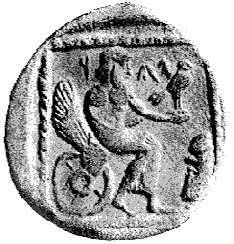

In this connection we must take account of a unique silver drachma, or quarter-shekel, which has been for many years in the British Museum' (pl. xxi (47K) and fig. 17l a, b (17K)). It is struck on the Phoenician standard. The obverse shows a bearded head in three-quarter position (not double-struck) facing towards the right and wearing a crested Corinthian helmet with a bay-wreath upon it. The reverse has a square incuse surrounded by a spiral border, within which we see a bearded divinity enthroned. He wears a long garment, which covers his right arm and extends to his feet. He is seated on a winged and wheeled seat: the wing is archaic in type and rises high behind his back; the wheel has six spokes and an inner ring round its axle. The god has an eagle (or hawk ?) on his out-stretched left hand. Before him in the lower right hand corner of the square is an ugly bearded head. In the field above the seated deity are the Phoenician letters (see above), that is, YHW.
The credit of being the first to decipher and to interpret aright the inscription belongs to Monsieur C. Clermont-Ganneau. As far back as 1880 he suggested to Prof. P. Gardner and Dr B. V. Head that it was the triliteral form of the divine name Jehovah; and in l892, when lecturing at the College de France he treated it as such. Dr Ginsburg's rival attempt to read it as the name of Jehu, king of Israel makes shipwreck--as A. Neubauer was prompt to point out-- on the chronology, the coin being nearly five centuries later than Jehu's reign. There can, in fact, be little doubt that we have here a gentile representation of the Hebrew Godhead.
Now a bearded god enthroned with an eagle on his hand is a common art-type of Zeus. And it will be remembered that in 168 B.C. Antiochus iv Epiphanes transformed the temple at Jerusalem into a temple of Zeus Olympios and the temple on Mount Gerizim into a temple of Zeus Xenios or Hellenios. Further, the winged wheel is, as we have seen, solar in its origin. It follows that the coin represents Jehovah under the guise of a solar Zeus.
This conclusion is confirmed by the fact that Iao--the form usually taken by Jehovah's name in magical texts of the Hellenistic age--was equated sometimes with Zeus, sometimes with Helios. A papyrus at Berlin, acquired by Lepsius at Thebes in Egypt and published by Parthey in 1866, records an incantation, which begins by summoning Apollon in company with Paian to quit Parnassos and Pytho, and then continues in a quasi-Semitic strain:
Come, foremost angel of great Zeus Iao,
And thou too, Michael, who holdest heaven,
And, Gabriel, thou the archangel, from Olympos.
The Anastasy papyrus of the British Museum, published by Wessely in 1888, includes among other magical formulae the following prose invocation: ' I summon thee the, ruler of the gods--Zeus, Zeus, that thunderest on high, king Adonai, lord Iaoouee.' Apollon Klarios, whose ancient oracle near Kolophon in Asia Minor enjoyed a new lease of life in Roman times, was once questioned concerning the nature of the dread mysterious Iao. His answer has--thanks to Macrobius--been preserved:
They that know mysteries should conceal the same.
But, if thy sense be small and weak thy wit,
Mark as the greatest of all gods Iao--
In winter Hades, Zeus when spring begins,
Helios o' the summer, autumn's soft Iao.
Iao is here expressly identified with both Zeus and Helios. These identifications might be illustrated by some of the bizarre devices to be seen on Gnostic amulets. For example, an onyx published by Spon (fig. 172) represents a youthful, beardless Zeus enthroned with sceptre, thunderbolt, and eagle, the legend on the back being Iao Sabao(th)
The Phoenician quarter-shekel--to judge from its weight, style, and fabric--was struck about 350 B.C., and therefore furnishes our earliest evidence of Jehovah conceived by the gentiles as Zeus. Unfortunately we do not know where the coin was issued. The eminent numismatist J. P. Six ascribed it, along with a series of somewhat similar pieces, to Gaza Minoa in southern Palestine. If this attribution is sound--and it has been widely accepted,--I would suggest that the helmeted head with a bay-wreath on the obverse is that of Minos the eponymous founder, who figures as helmeted warrior holding the branch of a sacred bay-tree on later coins of the town (fig. 174). The grotesque face or mask on the reverse is probably, as E. Babelon surmised, that of Bes; and the bust of Bes too is a known type on autonomous silver coins of Gaza. Further, there was at Gaza an image of Io the moon- goddess with a cow beside it. And Iao, the supposed sun-god, was early represented as a golden calf'. Is it not permissible to think that the inhabitants of Gaza imported the cult of the Jewish deity as a pendant to that of their own Io ? Certainly their Cretan ancestors had worshipped the sun and the moon as a bull and a cow respectively. Nor need we be surprised at their borrowing the type of Triptolemos' throne, wheeled and winged. Triptolemos, according to Argive tradition, was the son of Trochilos, the 'Wheel'-man; and Trochilos in turn was the son of Kallithea, another name of Io. Moreover, Triptolemos is said to have gone eastwards in quest of lo, taking with him a company of Argives, who founded Tarsos in Kilikia, Ione or Iopolis on Mount Silpion in Syria--better known as Antiocheia on the Orontesa--, and even settled in Gordyene beyond the Tigris. If Triptolemos followed Io thus far afield, he may well have pursued her to Gaza.